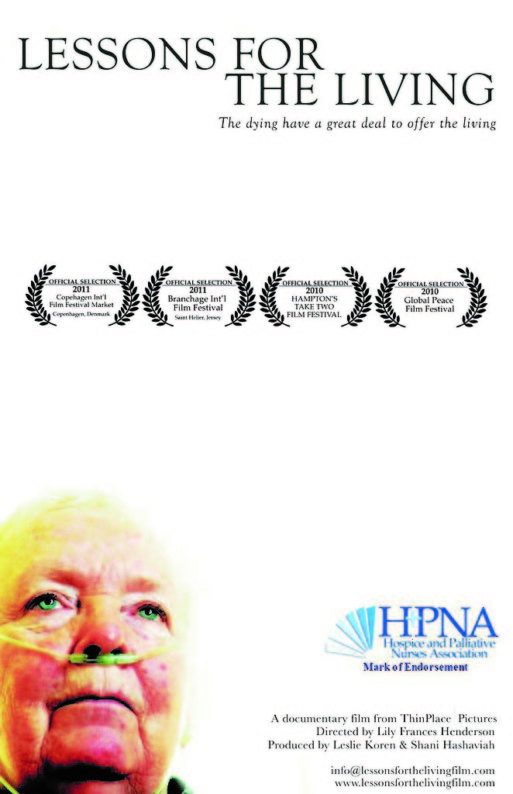 Lessons for the Living is a 2010 documentary directed by Lily Henderson that features a series of interviews with hospice volunteers as they reflect on their experiences in caring for dying people. The volunteers come from varied walks of life, ranging from a college student to a retired rabbi to a woman who is both a hospice volunteer and a hospice patient herself.
Lessons for the Living is a 2010 documentary directed by Lily Henderson that features a series of interviews with hospice volunteers as they reflect on their experiences in caring for dying people. The volunteers come from varied walks of life, ranging from a college student to a retired rabbi to a woman who is both a hospice volunteer and a hospice patient herself.
Having been a hospice volunteer, I so appreciated the candor with which the volunteers described their experiences, which were as diverse as the spectrum of spiritual beliefs, philosophical approaches to death and motivations they brought with them.
Leslie, the shamanic practitioner, references the spirits she calls in to work with her before she enters the room of a hospice patient. Kathleen Kelly, who is both a hospice volunteer and hospice patient with an estimated six months to live, who declares herself decidedly not “new-agey.” She says that her 10 years of hospice volunteering has taken the mystery out of death, which to her is as natural a process as eating and having a bowel movement.
Despite the different filters through which the volunteers view their work, there are some unifying themes – lessons in the film that I remember learning myself as a hospice volunteer. The volunteers speak of the contemplative, quiet space that the nature of the work induces, and how that impacts their lives outside the hospice unit. Multiple volunteers discuss the jarring experience of moving between the hospice unit and the outside world, a transition which I also remember having a difficult time navigating. Says Kristen, a hospice volunteer with six years of experience: “You’re seeing people so precious in the moment of life and death, and then you’re seeing masses of people oblivious to the fact that they’re dying moment by moment. And then it becomes surreal.”
“It allows me to treat everything I meet in the day with equanimity, to react to whatever I confront in a way that does not include any fears of the future or excess baggage from the past.”
The volunteers also spoke of the value of being able to sit in silence with the patient — how beneficial that is for both parties. Says Kathleen Kelly during her interview, “It’s just a time of concentration and quiet. It allows me to treat everything I meet in the day with equanimity, to react to whatever I confront in a way that does not include any fears of the future or excess baggage from the past.”
Over and over, the volunteers stress the importance of nonverbal communication and the value of simply sitting in silence with someone, no matter how uncomfortable that may feel initially. It takes some getting used to, and it requires the capacity to sit in silence with oneself, to relax into the expansiveness that stillness creates. Sitting in silence with the dying is stunningly profound for the volunteer who learns to hold that space for the patient. Jim, a salesman and hospice volunteer for a year and a half at the time of his interview, puts it this way, “Sitting in solitude is one thing to have a sense of empathy and interconnectedness. But to be with other people in such deep sorrow, something opens psychically. In those few moments after a loved one has died, something opens. Every human emotion is now wrapped up; you’re now confronted with it.”
In those few moments after a loved one has died, something opens. Every human emotion is now wrapped up; you’re now confronted with it.”
Hospice volunteers tend to be people who want to confront that spectrum of human emotion, who want to look the whole of what it means to be a human in a mortal body straight on and attempt not to flinch. They are at the very least curious about it, and most of the time humbled and awed by it. That humility and awe, in my experience, is the greatest gift of hospice volunteering. This film does an excellent job of communicating that.
I will leave you with the words of Kathleen Kelly, who ends the film with one of the best lessons for the living I’ve ever heard. Hooked up to her oxygen tank with tubes in her nose, she looks directly into the camera and says, “I fear nothing. I hope for nothing. I am free. I’ve talked to people who say they feel sorry for me, not having any hope. Hope is a thief. I am living today as fully as I am able. I am resting up for a fabulous dinner party tonight. I’m in hospice; I’m on oxygen; I’m going to take my oxygen with me and I don’t know if I’m gonna be able to last the whole dinner party, but that is what I’m doing to the maximum degree that I am able. I hope for nothing. I am dealing with every moment that comes along to the maximum degree that I can. And that makes me happy. I’m a happy woman.”

 Lessons For the Living by Lily Henderson
Lessons For the Living by Lily Henderson



 Our Monthly Tip: Make an “In Case of Death” File to Ease Loved One’s Grief
Our Monthly Tip: Make an “In Case of Death” File to Ease Loved One’s Grief
 Passing of Beloved Comedian Births a New Comedy Festival
Passing of Beloved Comedian Births a New Comedy Festival















